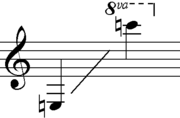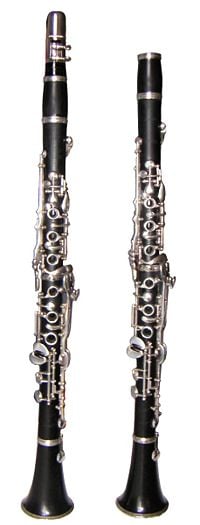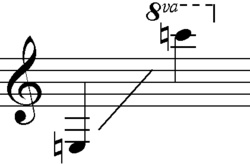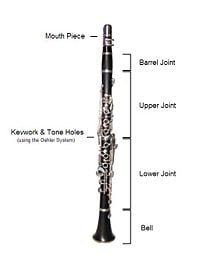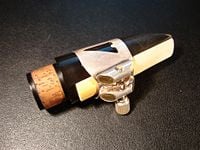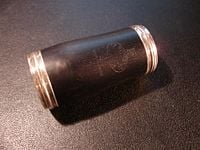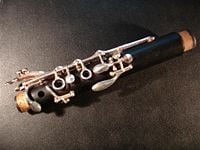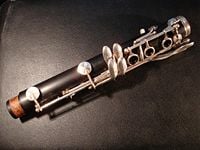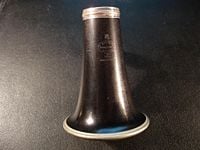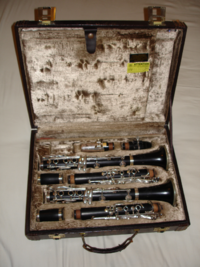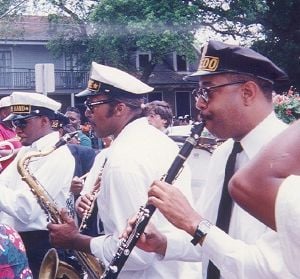Clarinet
|
The clarinet is a musical instrument in the woodwind family. The name derives from adding the suffix -et, meaning little, to the Italian word clarino, meaning a particular trumpet, as the first clarinets had a strident, but pleasing tone similar to that of a trumpet. The instrument has an approximately cylindrical bore, and uses a single reed. Through Johan Christoph Denner, Ivan Mueller ,and many other inventors and modifiers, humankind has been given the gift of musical tranquility. This is the essence of the modern clarinet's dark round tone.
Clarinets actually comprise a musical family of instruments of differing sizes and pitches. It is the largest such instrument family, with more than two dozen types. Of these many are rare or obsolete, and music written for them is usually played on one of the more common size instruments. The unmodified word clarinet usually refers to the Bā soprano clarinet, by far the most common clarinet.
A person who plays the clarinet is called a clarinetist, sometimes spelled "clarinettist."
Characteristics of the instrument
Tone
The clarinet has a distinctive timbre, resulting from the shape of the cylindrical bore, whose characteristics vary between its three main registers: The chalumeau (low), clarion or clarino (middle), and altissimo (high). It has a very wide compass, which is showcased in chamber, orchestral, and wind band writing. The tone quality varies greatly with the musician, the music, the style of clarinet, the reed, and humidity. The German (Oehler system) clarinet generally has a darker tone quality than the French (Boehm system). In contrast, the French clarinet typically has a lighter, brighter tone quality. The differences in instruments and geographical isolation of players in different nations led to the development, from the last part of the eighteenth century on, of several different schools of clarinet playing. The most prominent of these schools were the German/Viennese traditions and the French school, centered around the clarinetists of the Conservatoire de Paris. Increasingly, through the proliferation of recording technology and the internet, examples of many different styles of clarinet playing are available to developing clarinetists today. This has led to a decreased homogeneity of styles of clarinet playing. The modern clarinetist has an eclectic palette of "acceptable" tone qualities to choose from, especially when working with an open-minded teacher.
The A clarinet sound is a little darker, richer, and less brilliant than that of the more common Bā clarinet, though the difference is relatively small. The tone of the Eā clarinet is quite a bit brighter than any other member of the widely-used clarinet family and is known for its distinctive ability to cut through even loud orchestral textures. This effect was utilized by such twentieth century composers as Gustav Mahler, Aaron Copland, Dmitri Shostakovich, and Igor Stravinsky.
The bass clarinet has a characteristically deep, mellow sound. The alto clarinet is similar in sound to the bass, and the basset-horn has a tone quality similar to the A clarinet.
Range
The bottom of the clarinetās written range is defined by the keywork on each particular instrument; there are standard keywork schemes with some variability. The actual lowest concert pitch depends on the transposition of the instrument in question; in the case of the Bā, the concert pitch is a whole tone lower than the written pitch. Nearly all soprano and piccolo clarinets have keywork enabling them to play the E below middle C as their lowest written note.
Most alto and bass clarinets have an extra key to allow a low Eā. Modern professional-quality bass clarinets generally have additional keywork to low C. Some of the less commonly encountered members of the clarinet family, namely the contra-alto and contrabass clarinets, may have keywork to low Eā, D, or C; the basset clarinet and basset horn generally go to low C.
Defining the top end of a clarinetās range is difficult, since many advanced players can produce notes well above the highest notes commonly found in method books. The āhigh Gā two octaves plus a perfect fifth above middle C is routinely encountered in advanced material and in the standard literature through the nineteenth century. The C above is attainable by most advanced players and is shown on many fingering charts. Many professional players are able to extend the range even higher. Less advanced players may have great difficulty making these notes sound "in tune" without very good technique, even if they can produce a pitch with the proper fingering.
The range of a clarinet can be divided into three distinctive registers. The lowest notes, up to the written Bā above middle C, is known as the chalumeau register (named after the instrument that was the clarinet's immediate ancestor), of which the top four notes or so are known as the "throat tones." Producing a blended tone with the surrounding registers takes much skill and practice.
The middle register is termed the clarion register and spans just over an octave (from written B above middle C, to the C two octaves above middle C). The top, or altissimo register consists of the notes from the written CāÆ two octaves above middle C and up.
Construction and acoustics
Professional clarinets are usually made from African hardwood, often grenadilla, rarely (because of diminishing supplies) Honduran rosewood, and sometimes even cocobolo. Historically, other woods like the boxwood, were used. Buffet-Crampon's Greenline professional clarinets are made from a composite mixture of plastic resin and wood chipsāsuch instruments are less affected by humidity, but are heavier than the equivalent wood instrument. Student instruments are sometimes made of composite material or plastic resin, commonly "resonite," which is an Acrylonitrile butadiene styrene (ABS) resin. Metal soprano clarinets were popular in the early twentieth century, until plastic instruments supplanted them. Metal construction is still used for some contra-alto and contrabass clarinets. Mouthpieces are generally made of ebonite, although some inexpensive mouthpieces may be made of plastic. The instrument uses a single reed made from the cane of Arundo donax, a type of grass. Reeds may also be manufactured from synthetic materials. The ligature fastens the reed to the mouthpiece. When air is blown through the opening between the reed and the mouthpiece facing, the reed vibrates and produces the instrument's sound.
While a few clarinetists make their own reeds, most buy manufactured reeds, though many players make adjustments to these reeds to improve playability. Clarinet reeds come in varying "strengths" generally described from "soft" to "hard." It is important to note that there is no standardized system of designating reed strength. Beginning clarinetists are often encouraged to use softer reeds. Jazz clarinetists often remain on softer reeds, as they are more suitable for bending pitch. Most classical musicians work towards harder reed strengths as their embouchures strengthen. The benefit of a harder reed is a sturdy, round tone. However it should be noted that the strength of the reed is only one factor in the player's set-up; the characteristics of the mouthpiece are also critical, and indeed the reed strength should be matched to the mouthpiece. The major manufacturers of clarinet reeds include Gonzales, Rico, Vandoren, and Clarinet makers, among others.
The body of a modern soprano clarinet is equipped with numerous tone holes, of which seven (six front, one back) are covered by the fingertips and the rest are opened or closed using a complicated set of keys. These tone holes allow every note of the chromatic scale to be produced. On bass and larger clarinets, some alto clarinets, and a few soprano clarinets, some or all of the finger holes are replaced by key-covered holes. The most common system of keys was named the Boehm System, by its designer Hyacinthe KlosƩ in honor of the flute designer, Theobald Boehm, but is not the same as the Boehm System used on flutes. The other main system of keys is called the Oehler system and is used mostly in Germany and Austria. Related is the Albert System used by some jazz, klezmer, and eastern European folk musicians. The Albert and Oehler systems are both based on the earlier Ivan Mueller system.
The hollow bore inside the instrument has a basically cylindrical shape, being roughly the same diameter for most of the length of the tube. There is a subtle hourglass shape, with its thinnest part at the junction between the upper and lower joint. This hourglass figure is not visible to the naked eye, but helps in the Acoustic resonance of the sound. The diameter of the bore affects characteristics such as the stability of the pitch of a given note, or, conversely, the ability with which a note can be "bent" in the manner required in jazz and other styles of music. The bell is at the bottom of the instrument and flares out to improve the tone of the lowest notes.
A clarinetist moves between registers through use of the register key, or speaker key. The fixed reed and fairly uniform diameter of the clarinet give the instrument the configuration of a cylindrical stopped pipe in which the register key, when pressed, causes the clarinet to produce the note an intervalic twelfth higher, corresponding to the third harmonic series. The clarinet is therefore said to overblow at the twelfth. By contrast, nearly all other woodwind instruments overblow at the octave, or do not overblow at all. The "rackett" is the next most common Western instrument that overblows at the twelfth like the clarinet. A clarinet must therefore have holes and keys for nineteen notes (an octave and a half, from bottom E to Bā) in its lowest register to play a chromatic scale. This fact at once explains the clarinet's great range and its complex fingering system. The fifth and seventh harmonics are also available to skilled players, sounding a further sixth and fourth (actually a very flat diminished fifth) higher respectively.
The highest notes on a clarinet can have a piercing quality and can be difficult to tune precisely. Individual instruments can be expected to play differently in this respect. This becomes critical if a number of instruments are required to play a high part in unison. Fortunately for audiences, disciplined players can use a variety of fingerings to introduce slight variations into the pitch of these higher notes. It is also common for high melody parts to be split into close harmony to avoid this issue.
Since approximately 1850, clarinets have been nominally tuned according to 12-tone equal temperament. Older clarinets were nominally tuned to the "meantone," and a skilled performer can use his or her embouchure to considerably alter the tuning of individual notes.
Components of a modern soprano clarinet
A Boehm system soprano clarinet is shown in the photos illustrating this section. However, all modern clarinets have similar components.
The reed is attached to the mouthpiece by the ligature and the top half-inch or so of this assembly is held in the playerās mouth. (German clarinetists usually use windings of string instead of a ligature.) The formation of the mouth around the mouthpiece and reed is called the embouchure.
The reed is on the underside of the mouthpiece pressing against the player's bottom lip, while the top teeth normally contact the top of the mouthpiece (some players roll the upper lip under the top teeth to form what is called a "double-lip" embouchure). Adjustments in the strength and configuration of the embouchure change the tone and intonation or tuning. It is not uncommon for clarinetists to employ methods to soften the pressure on both the upper teeth and inner lower lip by respectively attaching pads to the top of the mouthpiece and putting temporary padding on the front lower teeth, commonly from folded paper.
Next is the short barrel; this part of the instrument may be extended in order to fine-tune the clarinet. As the pitch of the clarinet is fairly temperature sensitive some instruments have interchangeable barrels whose lengths vary very slightly. Additional compensation for pitch variation and tuning can be made by increasing the length of the instrument by pulling out the barrel, particularly common in group playing in which clarinets are tuned to other instruments (such as in an orchestra). Some performers employ a single, synthetic barrel with a thumbwheel that enables the barrel length to be altered on the fly. On basset horns and lower clarinets, the barrel is usually replaced by a curved metal neck.
The main body of most clarinets is divided into the upper joint whose holes and most keys are operated by the left hand, and the lower joint with holes and most keys operated by the right hand. Some clarinets have a single joint. On some basset horns and larger clarinets, the two joints are held together with a screw clamp and are usually not disassembled for storage. The left thumb operates both a tone hole and the register key. Interestingly, on some models of clarinet, such as many Albert system clarinets and increasingly some higher-end Boehm system clarinets, the register key is a "wraparound" key, with the key on the back of the clarinet and the pad on the front. As well as the slightly exotic look this lends to the clarinet, advocates of the wraparound register key comment about an improved sound, as well as the benefit that it is harder for condensation to accumulate in the tube beneath the pad.
The cluster of keys at the bottom of the upper joint (protruding slightly beyond the cork of the joint) are known as the trill keys and are operated by the right hand. These give the player alternative fingerings which make it easier to play ornaments and trills that would otherwise be awkward. The entire weight of the smaller clarinets is supported by the right thumb behind the lower joint on what is called the thumb-rest. Basset horns and larger clarinets are supported with a neck strap or a floor peg.
Finally, the flared end is known as the bell. Contrary to popular belief, the bell does not amplify the sound; rather, it improves the uniformity of the instrument's tone for the lowest notes in each register. For the other notes, the sound is produced almost entirely at the tone holes and the bell is irrelevant. As a result, when playing to a microphone, the best tone can be recorded by placing the microphone not at the bell but a little way from the finger-holes of the instrument. This relates to the position of the instrument when playing to an audience which is pointing down at the floor, except in the most vibrant parts of certain styles of music. On basset horns and larger clarinets, the bell usually is made of metal, and curves up and forward instead of pointing down.
The reason that the most popular soprano clarinets are in Bā, A, and Eā has to do partly with the history of the instrument, and partly with acoustics and aesthetics. Before about 1800, due to the lack of airtight pads (as explained below in History), practical woodwinds could have only a few keys to control accidentals (notes outside their diatonic home scales). Because clarinets overblow at the twelfth rather than the octave, they need keys to control more notes in each register than oboes, flutes, or bassoons do. Therefore clarinets with few keys cannot easily play an in-tune chromatic scale, limiting any such instrument to a few closely related key signatures. For example, an eighteenth century clarinet in C could readily be played in Bā, F, C, G, and D (and their relative minors), but not (easily) keys outside this range. As key technology improved and more keys were added to woodwinds, the need for instruments in multiple musical keys was reduced. For octave-overblowing instruments, a single instrument in C can readily be played in any key. For clarinets, the use of more than one instrument in different keys persisted, with instruments in Bā and A used in addition to the C instrument in the lower soprano range.
Because the acoustics of the clarinet mean that the deeper the instrument is in pitch, the more "mellow" (less bright) it sounds, the C clarinet, being the shortest and therefore brightest instrument of the three, eventually fell out of favor, as the other two clarinets could play its range of keys between them and their sound was considered better. As more technical improvements were made, and the clarinet became equal tempered, the need for two clarinets was reduced. Yet, the difficulties for the player playing in remote keys remains and thus the A has remained a useful orchestral instrument.
Similarly, there have been Eā and D instruments in the upper soprano range, Bā, A, and C instruments in the bass range, and so forth; but over time the Eā and Bā instruments have become predominant.
Usage and repertoire of the clarinet
Clarinets have a very wide compass, which is showcased in chamber, orchestral, and wind band writing. Additionally, improvements made to the fingering systems of the clarinet over time have enabled the instrument to be very agile; there are few restrictions to what it is able to play.
Classical music
In European classical music, clarinets are part of the standard orchestral instrumentation, which frequently includes two clarinetists playing individual partsāwith each player usually equipped with a pair of standard clarinets in Bā and A. Clarinet sections grew larger during the nineteenth century, employing a third clarinetist or a bass clarinet. In the twentieth century, composers such as Igor Stravinsky, Richard Strauss, and Olivier Messiaen enlarged the clarinet section on occasion to up to nine players, employing many different clarinets including the Eā or D soprano clarinets, basset-horn, bass clarinet and/or contrabass clarinet.
This practice of using a variety of clarinets to achieve coloristic variety was common in twentieth century classical music and continues today. It is quite common for clarinet parts to alternate between Bā and A instruments several times over the course of a movement. However, many clarinetists and conductors prefer to play parts originally written for obscure instruments such as the C or D clarinets on Bā or Eā clarinets, which are of better quality and more prevalent and accessible.
The clarinet is widely used as a solo instrument. The relatively late evolution of the clarinet (when compared to other orchestral woodwinds) has left a considerable amount of solo repertoire from the Classical, Romantic, and Modern periods but few works from the Baroque era. A number of clarinet concertos have been written to showcase the instrument, with the concerti by Wolfgang Amadeus Mozart, Aaron Copland and Carl Maria von Weber being particularly well known.
Many works of chamber music have also been written for the clarinet. Particularly common combinations are:
- Clarinet and piano (including clarinet sonatas)
- Clarinet, piano and another instrument (for example, string instrument or voice)
- Clarinet Quintet, generally made up of a clarinet plus a string quartet,
- Wind Quintet, consists of flute, oboe, clarinet, bassoon, and horn.
- Trio d'Anches, or Trio of Reeds consists of oboe, clarinet, and bassoon.
- Wind Octet, consists of pairs of oboes, clarinets, bassoons, and horns.
- Clarinet, violin, piano
- Clarinet, viola, piano
Concert bands
In concert or wind bands, clarinets are a particularly central part of the instrumentation, occupying the same space (and often playing the same parts) in bands that the strings do in orchestras. Bands usually include several Bā clarinets, divided into sections each consisting of 2-3 clarinetists playing the same part. There is almost always an Eā clarinet part and a bass clarinet part, usually doubled. Alto, contra-alto, and contrabass clarinets are sometimes used as well, and very rarely a piccolo Aā clarinet.
Jazz
The clarinet was a central instrument in early jazz starting in the 1910s and remaining popular in the United States through the big band era into the 1940s. Larry Shields, Ted Lewis, Jimmie Noone, and Sidney Bechet were influential in early jazz. The Bā soprano was the most common instrument, but a few early jazz musicians such as Louis Nelson Deslile and Alcide Nunez preferred the C soprano, and many New Orleans jazz brass bands have used the Eā soprano.
Swing clarinetists such as Benny Goodman, Artie Shaw, and Woody Herman led successful and popular big bands and smaller groups from the 1930s onward. With the decline of the big bands' popularity in the late 1940s, the clarinet faded from its prominent position in jazz, though a few players (Buddy DeFranco, Eddie Daniels, Eric Dolphy, Jimmy Giuffre, Perry Robinson, and others) used clarinets in bebop and free jazz.
During the 1950s and 60s, Britain underwent a surge in the popularity of traditional jazz. During this period, a British clarinetist named Acker Bilk became popular, founding his own ensemble in 1956. Bilk had a string of successful records including the most popular, "Stranger on the Shore," a tune now synonymous with Acker Bilk himself.
Back in the United States, the instrument has seen something of a resurgence since the 1980s, with Eddie Daniels, Don Byron, and others playing the clarinet in more contemporary contexts. The instrument remains common in Dixieland music. Pete Fountain is one of the best known performers in this genre.
Filmmaker Woody Allen is a notable jazz clarinet enthusiast, and performs New Orleans-style jazz regularly with his quartet in New York.
Now, in the twenty-first century, there's been a growing popularity, for jazz genius, Gordon Goodwin, who arranged an astounding arrangement of Benny Goodman's "Sing Sing Sing." "Sing Sang Sung" is a clarinet feature with growing popularity.
Klezmer
Clarinets also feature prominently in much of the Klezmer music, which requires a very distinctive style of playing. This folk genre makes much use of quarter-tones, making a different embouchure (mouth position) necessary. Some Klezmer musicians prefer Albert system clarinets.
Groups of clarinets
Groups of clarinets playing together have become increasingly popular among clarinet enthusiasts in recent years. Common forms are:
- Clarinet choir, which features a large number of clarinets playing together, usually involving a range of different members of the clarinet family. The homogeneity of tone across the different members of the clarinet family produces an effect with some similarities to a human choir.
- Clarinet quartet, usually three Bā sopranos and one Bā bass, but also sometimes four Bā sopranos.
Clarinet choirs and quartets often play arrangements of both classical and popular music, in addition to a body of literature specially written for a combination of clarinets by composers such as Arnold Cooke, Alfred Uhl, Lucien Caillet and VĆ”clav NelhĆ½bel.
Extended family of clarinets
Clarinets other than the standard Bā and A clarinets are sometimes known as harmony clarinets. Moreover, there is a family of many differently-pitched clarinet types, some of which are very rare. The following are the most important sizes:
- Piccolo clarinet clarinet in Aā.
- Soprano clarinets in Eā, D, C, Bā, A and G. ( A Clarinets are useful in a symphony as to give the lead clarinet player an easier key signature to work with)
- Basset clarinet in A.
- Basset horn in F.
- Alto clarinet in Eā.
- Bass clarinet in Bā.
- Contra-alto clarinet in EEā.
- Contrabass clarinet in BBā.
Experimental EEEā octocontra-alto and BBBā octocontrabass clarinets have also been built.
History
The clarinet developed from a Baroque instrument called the chalumeau. This instrument was similar to a recorder, but with a single reed mouthpiece similar to that of the modern clarinet and a cylindrical bore. Lacking a register key, it was played only in its fundamental register, so it had a limited range of about one and a half octaves. It had eight finger holes, like a recorder, plus two keys for extra notes.
Around the end of the seventeenth century, the chalumeau was modified by converting one of its keys into a register key and produced the first clarinet. This development is attributed to a German instrument maker named Johann Christoph Denner. This instrument played well in the middle register with a loud, strident tone, so it was given the name clarinetto, meaning "little trumpet" (from clarino + -etto). Early clarinets did not play well in the lower register, so chalumeaux continued to be made to play the low notes and these notes became known as the chalumeau register. As clarinets improved, the chalumeau fell into disuse.
The original Denner clarinets had two keys, but various makers added more to get extra notes. The classical clarinet of Mozart's day would probably have had eight finger holes and five keys.
Clarinets were soon accepted into orchestras. Later models had a mellower tone than the originals. Mozart (d. 1791) liked the sound of the clarinet (he considered its tone the closest in quality to the human voice) and wrote much music for it. By the time of Ludwig van Beethoven (c. 1800-1820), the clarinet was a standard fixture in the orchestra.
The next major development in the history of clarinet was the invention of the modern pad. Early clarinets covered the tone holes with felt pads. Because these leaked air, the number of pads had to be kept to a minimum, so the clarinet was severely restricted in what notes could be played with a good tone. In 1812, Ivan Mueller, a Russian-born clarinetist and inventor, developed a new type of pad which was covered in leather or fish bladder. This was completely airtight, so the number of keys could be increased enormously. He designed a new type of clarinet with seven finger holes and thirteen keys. This allowed the clarinet to play in any key with near equal ease. Over the course of the nineteenth century, many enhancements were made to Mueller's clarinet, such as the Albert system and the Baermann system, all keeping the same basic design. The Mueller clarinet and its derivatives were popular throughout the world.
The final development in the modern design of the clarinet used in most of the world today, was introduced by Hyacinthe KlosƩ in 1839. He devised a different arrangement of keys and finger holes which allow simpler fingering. It was inspired by the Boehm system developed by Theobald Boehm, a flute maker who had invented the system for flutes. KlosƩ was so impressed by Boehm's invention that he named his own system for clarinets the Boehm system, although it is different from the one used on flutes. This new system was slow to catch on because it meant the player had to relearn how to play the instrument. Gradually, however, it became the standard, and today the Boehm system is used everywhere in the world except Germany and Austria. These countries still use a direct descendant of the Mueller clarinet known as the Oehler system clarinet. Also, some contemporary Dixieland and Klezmer players continue to use Albert system clarinets, as the simpler fingering system can allow for easier slurring of notes. At one time the reed was held on using string, but now the practice exists primarily in Germany and Austria, where the tone is preferred over that produced with the ligatures that are more popular in the rest of the world.
ReferencesISBN links support NWE through referral fees
- Bessaraboff, Nicholas. Ancient European Musical Instruments. Boston: Harvard University Press, 1941.
- Brymer, Jack. Clarinet. Kahn & Averill. ISBN 1-871-08212-9
- Pino, David. The Clarinet and Clarinet Playing. Providence: Dover Pubns, 1998. ISBN 0-486-40270-3
- Rendall, F. Geoffrey. The Clarinet. London: Ernest Benn Limited, 1957. ISBN 0-510-36701-1
- Shackleton, Nicholas. grovemusic.com/ Clarinet. Grove Music Online, ed. L. Macy. Retrieved February 21, 2006.
External links
All links retrieved December 19, 2023.
- "Clarinet acoustics: an introduction", University of New South Wales, Sydney, Australia.
- "Clarinet Fingering Charts", Woodwind Fingering Guide.
- "The clarinet in Latin America", Clariperu (Spanish language).
- The International Clarinet Association.
Credits
New World Encyclopedia writers and editors rewrote and completed the Wikipedia article in accordance with New World Encyclopedia standards. This article abides by terms of the Creative Commons CC-by-sa 3.0 License (CC-by-sa), which may be used and disseminated with proper attribution. Credit is due under the terms of this license that can reference both the New World Encyclopedia contributors and the selfless volunteer contributors of the Wikimedia Foundation. To cite this article click here for a list of acceptable citing formats.The history of earlier contributions by wikipedians is accessible to researchers here:
The history of this article since it was imported to New World Encyclopedia:
Note: Some restrictions may apply to use of individual images which are separately licensed.
